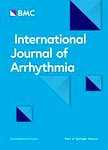版权所有:内蒙古大学图书馆 技术提供:维普资讯• 智图
内蒙古自治区呼和浩特市赛罕区大学西街235号 邮编: 010021
T=题名(书名、题名),A=作者(责任者),K=主题词,P=出版物名称,PU=出版社名称,O=机构(作者单位、学位授予单位、专利申请人),L=中图分类号,C=学科分类号,U=全部字段,Y=年(出版发行年、学位年度、标准发布年)
AND代表“并且”;OR代表“或者”;NOT代表“不包含”;(注意必须大写,运算符两边需空一格)
范例一:(K=图书馆学 OR K=情报学) AND A=范并思 AND Y=1982-2016
范例二:P=计算机应用与软件 AND (U=C++ OR U=Basic) NOT K=Visual AND Y=2011-2016

Conventional modality requires several days observation by Holter monitor to differentiate atrial fibrillation (AF) between Paroxysmal atrial fibrillation (PAF) and Non-paroxysmal atrial fibrillation (Non-PAF). Rapid and practical differentiating approach is needed.
To develop a machine learning model that observes 10-s of standard 12-lead electrocardiograph (ECG) for real-time classification of AF between PAF versus Non-PAF.
In this multicenter, retrospective cohort study, the model training and cross-validation was performed on a dataset consisting of 741 patients enrolled from Severance Hospital, South Korea. For cross-institutional validation, the trained model was applied to an independent data set of 600 patients enrolled from Ewha University Hospital, South Korea. Lasso regression was applied to develop the model.
In the primary analysis, the Area Under the Receiver Operating Characteristic Curve (AUC) on the test set for the model that predicted AF subtype only using ECG was 0.72 (95% CI 0.65–0.80). In the secondary analysis, AUC only using baseline characteristics was 0.53 (95% CI 0.45–0.61), while the model that employed both baseline characteristics and ECG parameters was 0.72 (95% CI 0.65–0.80). Moreover, the model that incorporated baseline characteristics, ECG, and Echocardiographic parameters achieved an AUC of 0.76 (95% CI 0.678–0.855) on the test set.
Our machine learning model using ECG has potential for automatic differentiation of AF between PAF versus Non-PAF achieving high accuracy. The inclusion of Echocar
电话和邮箱必须正确填写,我们会与您联系确认。
版权所有:内蒙古大学图书馆 技术提供:维普资讯• 智图
内蒙古自治区呼和浩特市赛罕区大学西街235号 邮编: 010021

暂无评论